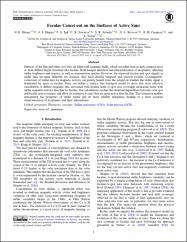Faculae cancel out on the surfaces of active suns

View/
Access
info:eu-repo/semantics/openAccessDate
2022Author
Nemec, N. E.Shapiro, A. I.
Işık, Emre
Sowmya, K.
Solanki, S. K.
Krivova, N. A.
Cameron, R. H.
Gizon, L.
Metadata
Show full item recordCitation
Nèmec, N. E., Shapiro, A. I., Işık, E., Sowmya, K., Solanki, S. K., Krivova, N. A., ... & Gizon, L. (2022). Faculae cancel out on the surfaces of active Suns. The Astrophysical Journal Letters, 934(2), L23.Abstract
Surfaces of the Sun and other cool stars are filled with magnetic fields, which are either seen as dark compact spots or more diffuse bright structures like faculae. Both hamper detection and characterization of exoplanets, affecting stellar brightness and spectra, as well as transmission spectra. However, the expected facular and spot signals in stellar data are quite different, for instance, they have distinct temporal and spectral profiles. Consequently, corrections of stellar data for magnetic activity can greatly benefit from the insight on whether the stellar signal is dominated by spots or faculae. Here, we utilize a surface flux transport model to show that more effective cancellation of diffuse magnetic flux associated with faculae leads to spot area coverages increasing faster with stellar magnetic activity than that by faculae. Our calculations explain the observed dependence between solar spot and facular area coverages and allow its extension to stars that are more active than the Sun. This extension enables anticipating the properties of stellar signal and its more reliable mitigation, leading to a more accurate characterization of exoplanets and their atmospheres.
















